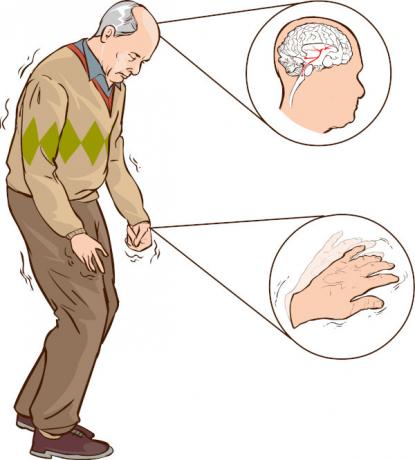THE Parkinson's disease it is mainly characterized by the development of tremors and was described in 1817 by James Parkinson. At the time, the disease was entitled "shaking paralysis", in reference to its symptoms. It later became known as Parkinson's disease, in reference to James Parkinson.
The development of the disease is related to the destruction of neurons producers of dopamine, not being the cause of this well-defined destruction. The first drug to treat the disease appeared in the 1960s, however, until today, no treatment is able to cure it. An estimated prevalence of the disease is 100 to 200 cases per 100,000 inhabitants.
Read more: Noradrenaline - when synthesized in the nervous system, acts as a neurotransmitter
What is Parkinson's Disease?
Parkinson's disease is a progressive and chronic neurological disorder that affects the central nervous system. The patient with this problem has progressive loss of neurons in the compact region of the substantia nigra, present in the midbrain. These neurons are known as
dopaminergics, which are responsible for releasing a neurotransmitter called dopamine, which, among other functions, is related to the movement of the body.
The reduction in the levels of dopamine in the individual's body is responsible for triggering the symptoms of Parkinson's disease. Symptoms are usually only noticed when these levels drop considerably. It is noteworthy, however, that they generally do not fall abruptly, being a disease that usually has a slow course.
What ages does Parkinson's disease affect?
Although the disease can affect younger individuals, it usually starts around 60 years of age, and it is estimated that around 1% of the population over the age of 60 years have it. When it affects individuals under 40 years of age, it is called Early-onset parkinsonism. With regard to sex, the disease affects both men and women.
What Causes Parkinson's Disease?
Parkinson's disease does not have a well-defined cause, however, a number of factors seem to be involved (multifactorial cause). Studies have related the disease to factors such as oxidative stress, alterations mitochondrial, changes resulting from aging, genetic factors and environmental toxins.
What are the signs and symptoms of Parkinson's disease?

When we talk about Parkinson's disease, the first symptom that comes to people's minds is the tremors, which usually start in the hands. However, several other symptoms may occur in the individual, who may also be slower to move and lean forward.
In general, we can say that Parkinson's disease presents as its main clinical manifestation the so-called parkinsonian syndrome. This syndrome, which can occur as a result of other illnesses or the use of some substances, is characterized by four basic symptoms: tremor at rest, postural instability, muscle rigidity and the call akinesia, which is the poverty of movements and the slowness of motor acts.
The motor symptoms of Parkinson's disease negatively impact the quality of life of patients, impairing activities such as writing, bathing and dressing.
It is noteworthy that Parkinson's disease can cause non-motor symptoms, such as memory problems, dementia, depression, anxiety, sleep disorders, speech disorders, hypotension and constipation. Among these symptoms, it is important to highlight cases of depression, which affect about a third of people with the disease.
Read more: Yellow September – suicide prevention campaign, which has depression as a cause
How is Parkinson's disease diagnosed?
The diagnosis of Parkinson's disease usually takes into account the clinical condition of the patient, since there are no accurate exams for this. Indication of the performance of brain tomography and magnetic resonance its purpose is to rule out other diseases that can cause a similar clinical picture in the patient. There is also the single-photon emission tomography, a test that helps quantify brain dopamine.
How is Parkinson's disease treated?
Many advances have been made since the initial description of Parkinson's disease, however, although there are medicines that help reduce signs and symptoms, none of them have curative capacity. Also, there are surgical treatments that aim to reduce tremors in the patient.
Surgery, however, is not recommended in all cases and should not be performed, for example, in people who have developed dementia. To ensure a better quality of life for the patient, it is recommended that the treatment be multidisciplinary, with a team composed of professionals such as physiotherapists, speech therapists and psychologists.
By Vanessa Sardinha dos Santos
Biology teacher
Source: Brazil School - https://brasilescola.uol.com.br/doencas/doenca-de-parkinson.htm
